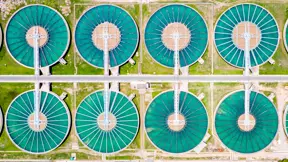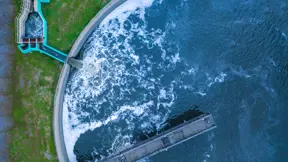
Reducing hydraulic loading to maximise efficiency in a WWTP
Discover how simulations helped predict improved treatment performance and reduced costs in a wastewater treatment plant
The managing water utility on the island of Bornholm is currently implementing a strategy to reduce water infiltration in sewers and minimise flood risks at the same time. Based on the result of a simulation study, the utility gained valuable information in the planning of significant investments in new separate sewer systems. DHI’s solution helped the utility quantify the benefits of the reduced hydraulic loading to Rønne WWTP by improving effluent quality and lowering operational costs.
Challenge
Rønne WWTP is the main wastewater treatment facility on the island of Bornholm, Denmark. The WWTP has traditionally been challenged by significant monthly variations in influent flow, mainly due to the contribution of stormwater and infiltration. High hydraulic loading is expected to have a negative impact on both treatment performance by affecting biological processes as well as operational costs due to increased energy consumption.
As part of a strategy to reduce sewer infiltration and minimise flood risks, Bornholms Energi & Forsyning (BEOF) has planned the implementation of separate sewer infrastructure and replacement of aged pipes. This solution is expected to reduce the hydraulic loading to Rønne WWTP, resulting in improved efficiency and potentially significant cost savings that can compensate for the investment in new infrastructure. However, an exact quantification of these impacts requires appropriate modelling tools that accurately describe the present and future operation of Rønne WWTP.
Solution
The effects of hydraulic loading reduction in terms of improved treatment performance, energy efficiency and operational cost savings were quantified using DHI’s modelling software WEST. The initiative is part of the EU-funded Interreg STEP (Sludge Technological Ecological Progress) project, which aims at improving resource recovery and energy efficiency in small to medium-sized WWTPs in the Baltic region.
To get actionable insights on the performance of Rønne WWTP, a model of the WWTP was implemented in WEST. The model included two separate lines for biological treatment (enhanced biological phosphorus removal with intermittent aeration) and subsequent chemical dosing. Influent characterisation was performed based on one-year measured data provided by operators and verified with independent measurements.
The model was first calibrated against influent and effluent concentrations of COD, N and P fractions, mixed liquor suspended solids in activated sludge reactors and overall energy consumption. The model was subsequently verified with specific measured data from one month during which the WWTP operated under reduced hydraulic loading.
The WEST model was then used to evaluate improvements in Rønne WWTP’s efficiency under varying influent flows. The maximum excess flow (stormwater, infiltration), which in the future will be reduced through implementation of separate sewers, was estimated to be 3800 m3/d. Several scenarios were simulated, each representing different degrees of interception of excess inflow:
- Baseline scenario with no excess inflow reduction
- Progressive excess inflow reduction simulating 20%, 40%, 60%, 80% excess inflow reduction
- Complete excess inflow reduction
Results
The results from the different simulations are presented for effluent quality, sludge production, energy consumption (pumping and aeration) and costs.
A complete reduction of excess inflow was estimated to provide for considerable improvements in terms of effluent quality (-12% to -50% effluent load), energy consumption (-418 kWh/d) and operational costs (-34%).
Considering an excess hydraulic loading of up to 3800 m3/d (accounting for 40% of average daily influent flow), it is estimated that every 20% step reduction of this excess flow will correspond to:
- 2%, 9% and 10% reduction in effluent BOD, N and P, respectively
- 4% reduction in energy consumption (pumping and aeration)
- 7% reduction in costs (effluent taxes, energy)
Upon complete reduction of the hydraulic overloading, savings in operational costs have been estimated to be DKK 350,000 per year, which can be further reinvested in the implementation of the strategy for infiltration and flood minimisation.
Client:
Bornholms Energi & Forsyning (BEOF)
Location:
Denmark
Related SDGs:
SDG 6: Ensure availability and sustainable management of water and sanitation for all
Technology:
About our client
Bornholms Energi & Forsyning (BEOF) is the managing utility company operating on the island of Bornholm, Denmark. It provides integrated water and energy services, and is responsible for the operation and maintenance of sewer systems and eight wastewater treatment plants.
You may also like
How can we help?
With our global network of offices, we make sure you get the right answers to your local needs. Tell us about your water challenges and we will get back to you.


